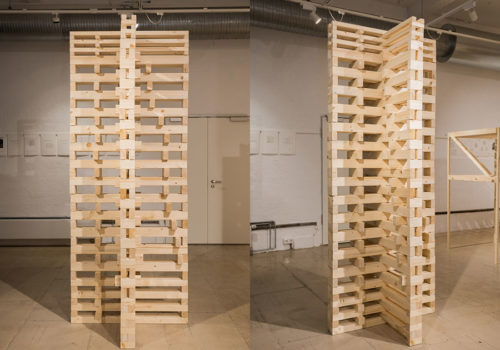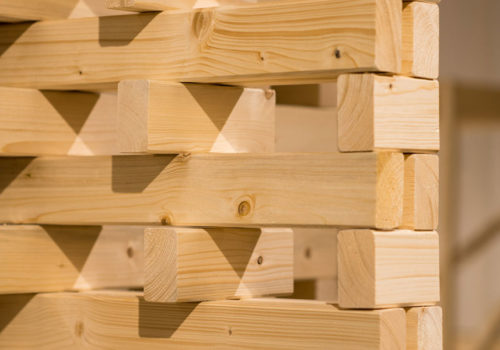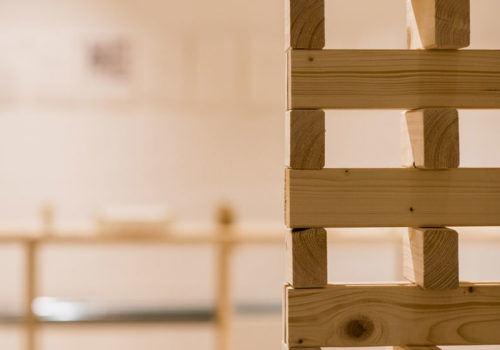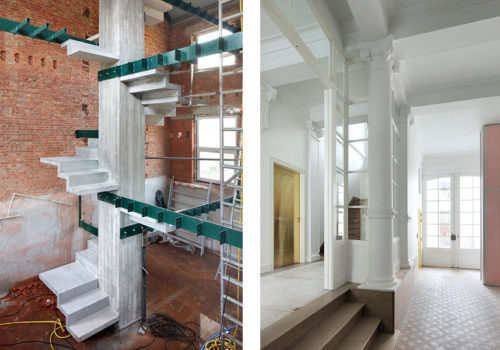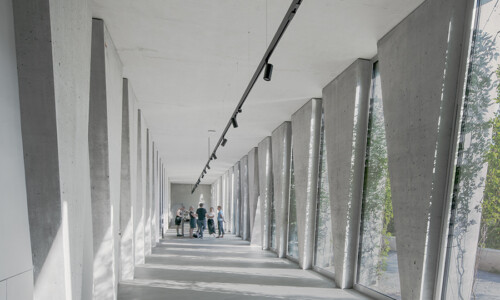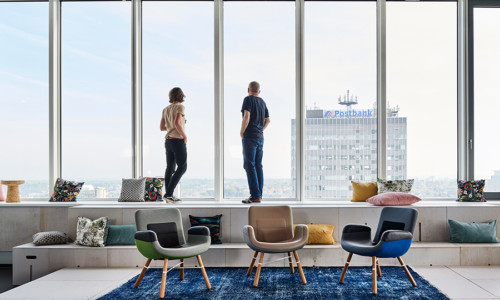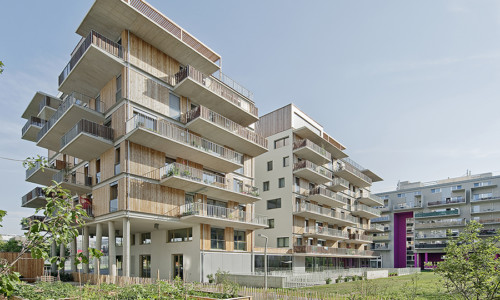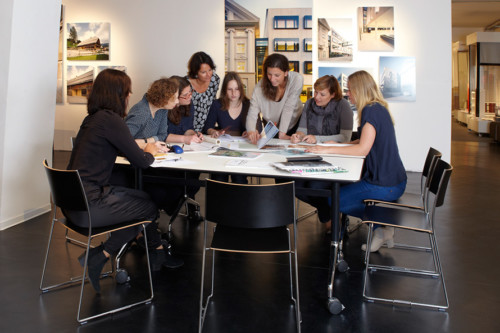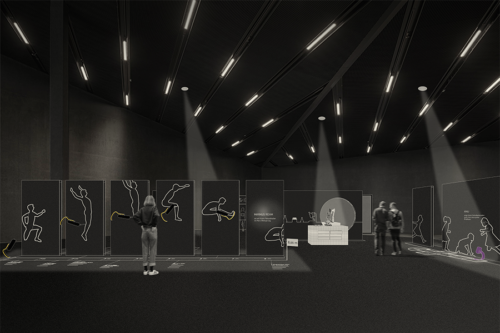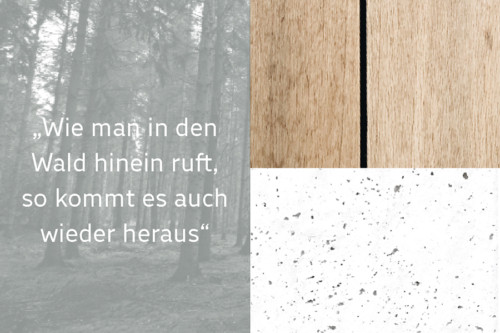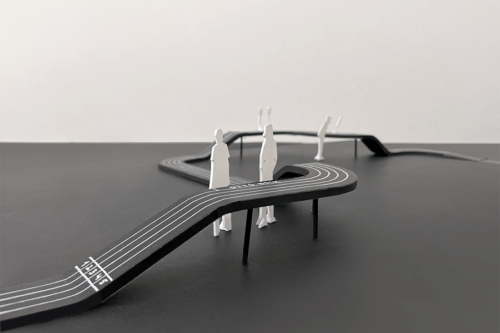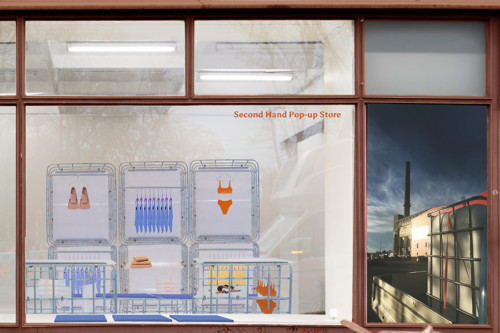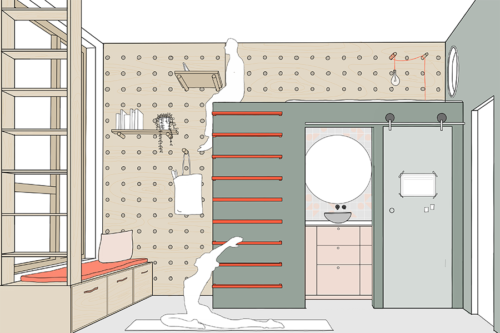Eagles of Architecture: Fusion zweier Kulturkreise
- Installation von Eagles of Architecture, AIT-ArchitekturSalon, München, 2020 © Schelke Fotografie
- © Schelke Fotografie
- © Schelke Fotografie
- Parthenon / Neue Nationalgalerie, Design: Mies van der Rohe / Tanikawa House, Design: Kazuo Shinohara (Japan) | © Eagles of Architecture
- Eagles of Architecture: House in Dendermonde und House number Five (Belgien) | © Foto: Eagles of Architecture
Das belgische Architekturkollektiv Eagles of Architecture entschied sich dafür, bei ihrem Entwurf für die Gruppenschau “Dialoge Japan : Europa” den Fokus auf ein einzelnes architektonisches Element zu legen: Die Stütze.
Ihre Installation ist eine Fusion der beiden Kulturkreise: Zum einen die gekreuzte Stütze von Mies van der Rohe in der Neuen Nationalgalerie, zum anderen eine Hommage an die japanische Holzbaukunst.
Bei früheren Bauwerken, wie dem House in Dendermonde sowie dem House number Five, aber auch bei ihrer ausgestellten Installation, beziehen sie sich auf zwei Vorbilder: Kazuo Shinohara und Mies van der Rohe, denen es mit ihrer Architektur gelang, über ein einzelnes Architekturelement ein Ereignis zu generieren. Diese Idee übernahmen Eagles of Architecture bereits in ihrem House number Five. Hier wird die Infrastruktur mittels einer Stütze mitten im Raum heruntergeleitet und nicht in der Wand versteckt. Spannend ist, dass der Raum dadurch seinen Charakter erfährt – man wird sich immer an diese Stütze erinnern.
Über die Idee hinter ihrem Entwurf und ihre Inspirationsquellen hat das Büro Eagles of Architecture mit uns in einem kurzen Interview gesprochen – lesen Sie mehr dazu.
Q1: What is the idea underlying the design and how does it articulate itself in the design?
The idea of the design is representing the column as an event. Here we tried to make a column that joins both cultures by making the crossed-form Mies column and building it with the art of Japanese joinery. By using 3 different sections of woodsticks we remark the Occidental tradition in recognizing the different parts of a column but building it in a framed wooden structures typical of Japanese tradition.
Q2: Which architect and building of Japanese culture (contemporary and historical) is most influential for you?
Kazuo Shinohara could be the Japanese architect with which we could find more related to. In his projects, Shinohara was searching for the abstract space, a space that invoked irrational feelings by introducing a surprise element of juxtaposition in the everyday experience of domestic space. With the structure as a critical role in his work, he tried to reinvent conventional construction methods and carry structural possibilities to the limit. The structure plays a major compositional role and the elements are emphasized by their “nakedness”.
When explaining the Tanikawa House, the architect said “It’s components are fragmented objects conveying neutral and inorganic meaning, which are not assembled to constitute a unified concept of space. Upon entering this structure formed from naked objects, the observer can freely read from it diverse and infinite meanings. Such a structure could be regarded as an apparatus for production of meaning. This structure, therefore, can be thought as a machine.”
Q3: Are there essential differences and commonalities between the two building cultures?
What we find interesting is the way how both cultures search space in the interplay between columns, walls and both the horizontal and vertical plane. A column has not just an structural meaning but is also a sign or event. In both cultures, modern architects attempted to deconstruct the architectonic elements of traditional architecture.
Eagles of Architecture, BE-Antwerpen
Das Architekturkollektiv Eagles of Architecture wurde von Andrea Marrodan Hernandez, Bart Hollanders, Mathias Bastiaensen und David Rodriguez Amor gegründet und ging aus dem früheren Architekturbüro 1: 1 architecture hervor. Unter ihrem neuen Namen arbeiten die vier Gründer aus Spaß an der Freude an verschiedenen Projekten und nicht aus Unternehmergeist. Für jeden Entwurf entwickeln sie ein Set von Spielregeln, die manchmal auf ein Folgeprojekt angewendet werden, manchmal nicht. Der Name Eagles of Architecture stellt durch den gewählten Plural zum einen das Bestreben in den Fokus, in einer Gruppe zu arbeiten, die folgende Präposition und das gewählte Singular zeigen aber auch auf, dass diese Zusammenarbeit nicht unbegrenzt ist. Gemeinsame Überzeugungen halten die Gruppe zusammen.
The Architectural collective Eagles of Architecture was founded by Andrea Marrodan Hernandez. Bart Hollanders. Mathias Bastiaensen und David Rodriguez Amor and grew out of the former architectural office 1 : 1 architecture. Under its new name it makes drawings and works on projects out of a desire to play rather than out of a sense of entrepreneurship. For each design it develops a set of playing rules which are sometimes passed on to a following project. sometimes not. The ambition to work in a group is clear from the plural in the name. but the following preposition and the explicit singular reveal that this collaboration is not open-ended. Shared convictions hold the group together.
Weitere Informationen zur Gruppenschau sowie eine virtuelle Führung durch die Ausstellung finden Sie hier.
Kuratiert wurde die Ausstellung “Dialoge Japan : Europa” von Kristina Bacht und Çi?dem Arsu-Minuth (AIT-ArchitekturSalon) in Zusammenarbeit mit Nils Rostek (Kollektiv A).






